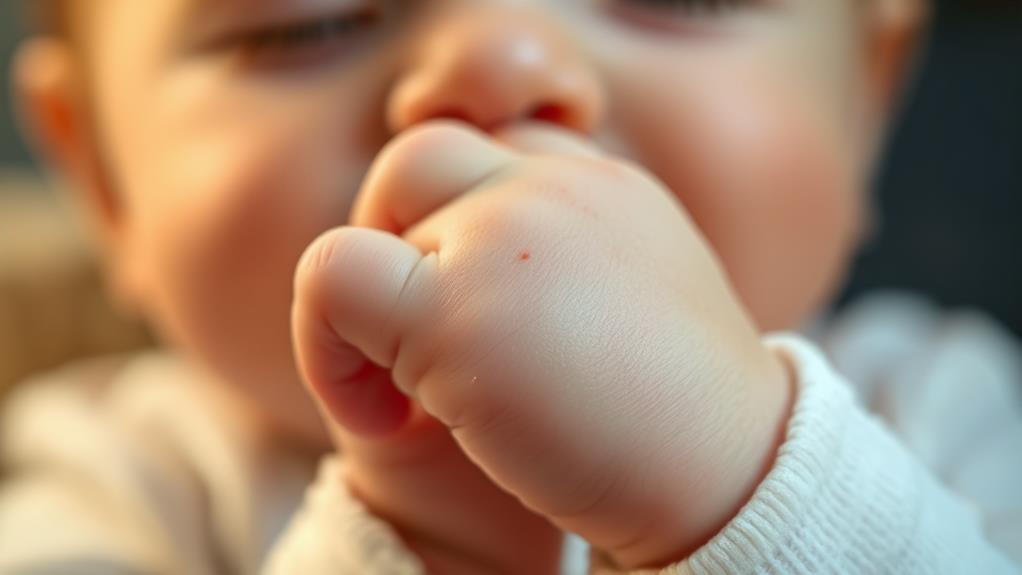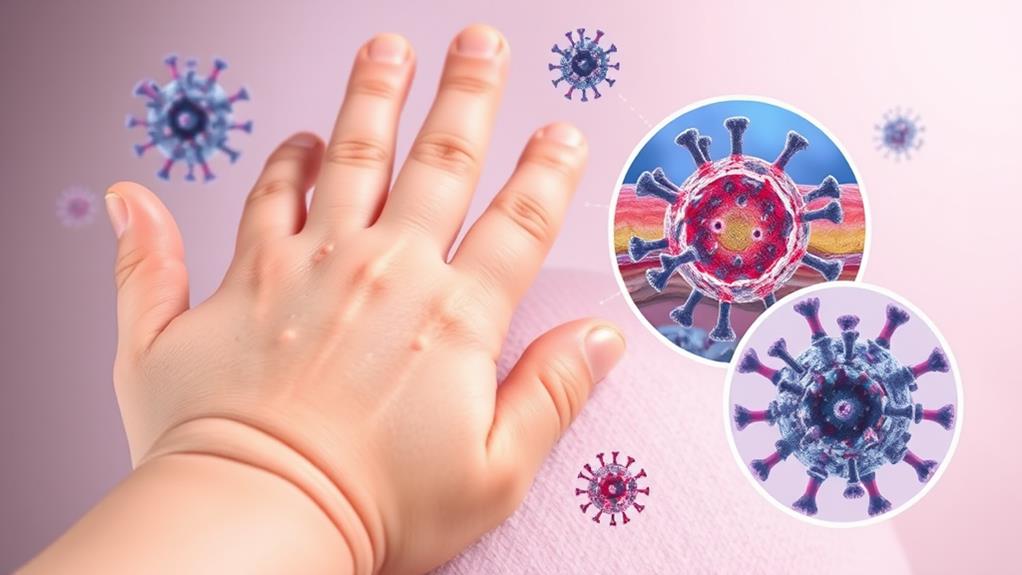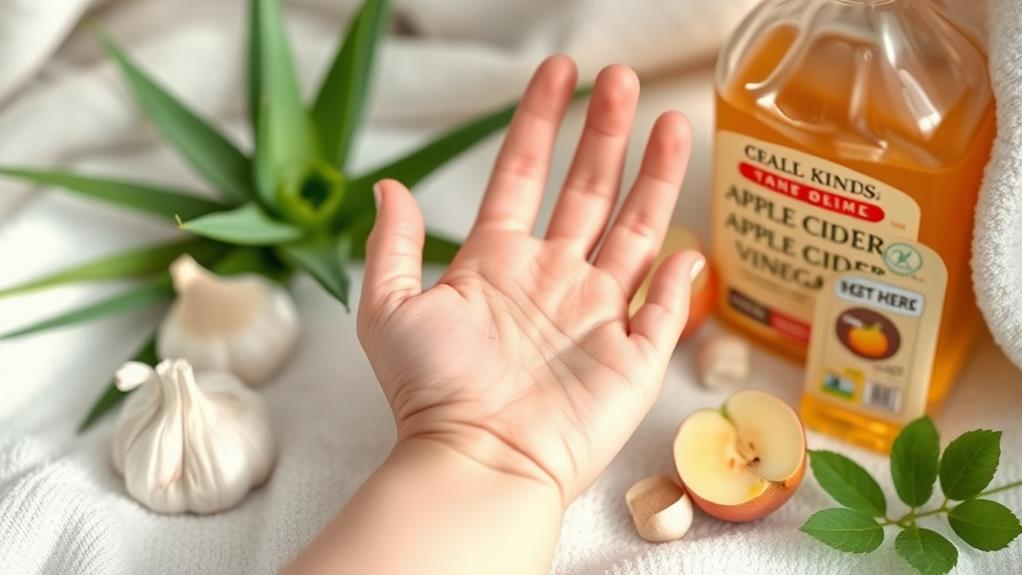If you've noticed warts on your baby, you might be wondering what's causing these common skin growths. These harmless bumps can take various forms, and while they often don't cause discomfort, understanding their types and origins can help you navigate your concerns. You may also be curious about effective treatments and preventive strategies to keep your baby safe. As you consider the best course of action, you'll want to explore the nuances of warts further, especially when it comes to distinguishing fact from fiction surrounding their management and prevention.
Understanding Warts in Babies

Warts in babies are surprisingly common, and understanding them can help ease your concerns. You might be wondering what those little bumps are and if they're something to worry about.
The good news is that most warts are harmless and often go away on their own. They're caused by a virus called the human papillomavirus (HPV), which can sneak its way into your baby's skin through tiny cuts or scratches.
Don't fret too much if your little one gets a wart. They can pop up anywhere, but you might find them on fingers, knees, or even the soles of their feet.
While they might look a bit odd, they usually don't hurt or itch.
Common Types of Warts
You'll encounter several common types of warts that can appear on your baby's skin.
First up are common warts, which often show up on fingers, elbows, or knees. They look like small, raised bumps and may have a rough surface.
Then, there are plantar warts, which can pop up on the soles of your baby's feet. These can be a bit painful, especially when your little one walks, so keep an eye out for any signs of discomfort.
Another type is flat warts, which are usually smooth and can appear anywhere, but most often on the face, arms, or legs. They're small and may not be as noticeable, but they can be a bit pesky.
Finally, you might hear about filiform warts. These warts are long and thin, often appearing around the mouth or nose. They can look like little threads sticking out from the skin.
While warts can be annoying, they're generally harmless.
Causes of Warts

Several factors contribute to the development of warts in babies. First and foremost, warts are caused by human papillomavirus (HPV). This virus enters the skin through tiny cuts or scratches, which can happen easily, especially when your little one is busy exploring the world.
Babies often put their hands in their mouths or crawl around, increasing their chances of coming into contact with the virus.
Another factor is the baby's immune system. Since infants are still developing their defenses, they mightn't fight off the virus as effectively as older kids or adults. If your baby has a weaker immune system, they're more likely to develop warts.
Genetics can also play a role. If you or other family members have a history of warts, your baby might be more prone to getting them, too.
Lastly, warts are more common in warm, moist environments, like locker rooms or swimming pools. Keeping your baby's skin clean and dry can help reduce their risk.
Symptoms to Watch For
When it comes to recognizing warts in babies, there are a few key symptoms to watch for. First off, look for small, rough bumps on your baby's skin. These can pop up anywhere, but they're often found on the fingers, knees, or elbows.
You might notice that some warts have a slightly raised surface, while others can be flat or even look like tiny cauliflower heads.
Another thing to keep an eye out for is any changes in the skin. If a bump starts to grow or change color, it's a sign you should pay attention. Warts can sometimes feel itchy or cause discomfort, so if your baby seems to be fussing more than usual, it might be worth checking.
Lastly, remember that warts can be contagious. If you see a wart, try to avoid letting your baby touch it, and wash your hands frequently.
While warts are usually harmless, it's always good to stay informed and keep an eye out for these symptoms. After all, you want your little one to have happy, healthy skin!
Diagnosis and Examination

How can you guarantee your baby's warts are properly diagnosed? First, you'll want to visit a pediatrician or dermatologist. They're the experts who can take a close look at your baby's warts and assess them accurately.
It's usually a simple process, often just involving a visual examination. Don't worry; it's not like they need a magnifying glass or a lab coat!
Your doctor might ask you some questions, like when you first noticed the warts and if they've changed in appearance. It's helpful to share any symptoms your baby might have, like itching or discomfort.
Sometimes, they may recommend a biopsy, but that's pretty rare for warts. If the warts look a bit unusual, your doctor will want to rule out other skin conditions.
They might even explain how warts are caused by viruses, which is good to know. Remember, warts are usually harmless, but getting a proper diagnosis helps you feel reassured.
Plus, it's a great way to bond with your little one while you're both figuring out this wart situation together. So, grab that appointment and let's get those warts checked out!
Treatment Options Available
Treating warts in babies can feel overwhelming, but there are effective options available. First, it's important to know that many warts go away on their own, so sometimes, patience is key.
However, if you want to speed things up, you can consider some treatment options with your pediatrician.
One common method is cryotherapy, which involves freezing the wart with a special spray. It might sound a bit scary, but it's usually quick and doesn't hurt much.
Another option is topical treatments, which are creams or solutions applied directly to the wart. These can help peel away the wart over time, but be sure to follow your doctor's instructions carefully.
In some cases, your doctor might suggest laser therapy or minor surgery to remove the wart. While these methods are effective, they're typically reserved for stubborn warts that don't respond to other treatments.
Remember, whatever treatment you choose, your baby's comfort and safety should always come first.
Home Remedies for Warts

Several home remedies can help manage warts in babies, providing gentle alternatives to more invasive treatments.
One popular option is applying apple cider vinegar. Just dab a small amount on the wart and cover it with a bandage overnight. This vinegar's acidity might help break down the wart tissue. You might want to try this for a week or so.
Another remedy is using duct tape. Yes, you heard that right! Cover the wart with duct tape for six days, and then soak it in warm water. Gently rub it with a pumice stone or emery board. It sounds funny, but many people swear by it.
Banana peels are also said to be helpful. Simply take a piece of the peel and place it on the wart, securing it with a bandage. Let it work its magic overnight.
Lastly, don't forget the power of good hygiene. Keeping the area clean and dry can help prevent further warts.
When to Seek Medical Help
Sometimes, it can be tricky to know when to seek medical help for warts in babies. You might wonder if those little bumps are just normal or something to worry about. If the wart starts to bleed, ooze, or get really red and swollen, it's time to call your doctor. Don't wait around, as that could mean it's become infected.
Also, if the warts are spreading quickly, or if your baby seems to be in pain or discomfort, don't hesitate to reach out for professional advice. Warts can be stubborn little things, and sometimes home remedies just won't cut it.
If your baby's warts are large or located in sensitive areas, like the face or genitals, it's best to consult a healthcare provider. They'll know how to safely treat them and help ease your worries.
And hey, if you're not sure about anything, a quick call to your pediatrician is always a good idea. Better safe than sorry, right?
Preventive Measures

Preventing warts in babies involves a few simple yet effective strategies. First, keep your little one's skin clean and dry. Warts love to hang out in warm, damp places, so make sure to dry their hands after washing and keep their feet dry, too.
Next, avoid sharing personal items like towels, socks, or shoes. It might seem silly, but sharing these things can help spread the virus that causes warts.
Also, encourage your baby to avoid touching warts on themselves or others. It might be hard to explain to a baby, but you can try distracting them with a toy or a fun song when they reach for a wart!
If your baby is in a daycare or playgroup, make sure they're washing their hands regularly. Teaching them the importance of good hygiene can go a long way. It's all about creating healthy habits early on.
Lastly, keep an eye on any cuts or scrapes. Treating these quickly can help prevent warts from forming.
Myths and Misconceptions
Warts in babies are often surrounded by various myths and misconceptions that can lead to unnecessary worry. One common myth is that warts are contagious. While the virus that causes warts can spread, it usually requires direct contact with the wart or a surface it's touched. So, don't panic! Your baby won't catch warts just by being in the same room as another child who's them.
Another misconception is that warts are a sign of poor hygiene. In reality, warts can happen to anyone, even the cleanest of babies. They're just pesky little growths caused by the human papillomavirus (HPV).
Some folks believe that warts need to be treated right away. In most cases, they may disappear on their own without any treatment. While it's good to keep an eye on them, you don't need to rush to the doctor unless they're causing discomfort or seem unusual.
Lastly, don't worry about them being a serious health issue. Warts are generally harmless. So, if your baby has a wart, take a deep breath and remember, it's just a little bump on the road to growing up!
